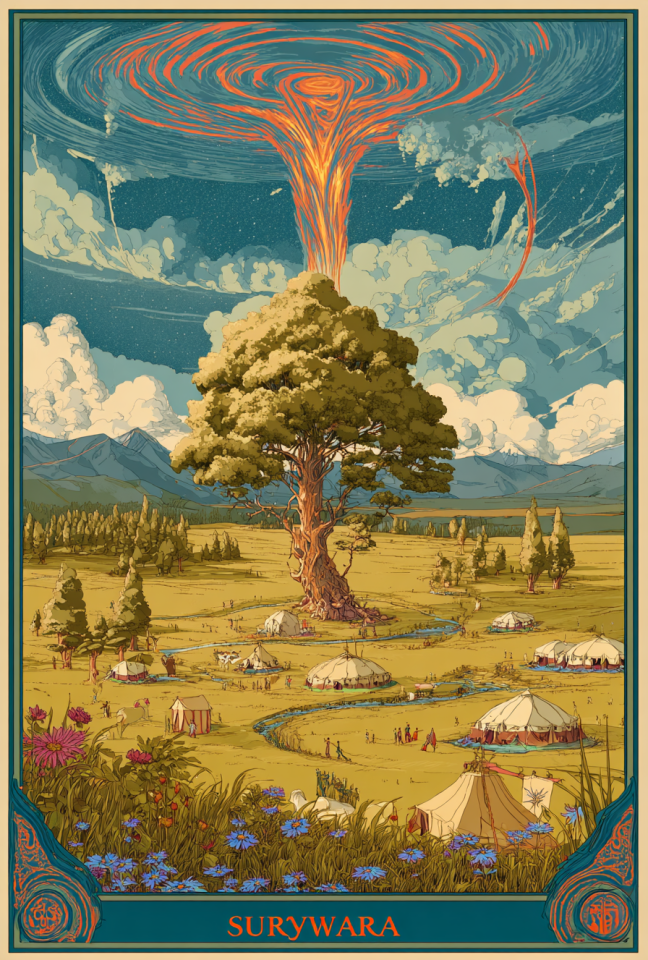Sūrāwāra (soo-RAH-wah-rah)
The Spiritual Compass
Sūrāwāra is the sacred steppe the Divine Realm of the Scythians — a boundless expanse of wild grasses, celestial wind, and ancestral fire. It is ruled in tandem by Artimpasa goddess of life, war, and prophecy, and Gaiϑāsūra the ancestral spirit-lord whose flaming gaze marks the path of divine kinship. Sūrāwāra is neither heaven nor underworld, but a liminal plain : the place where warriors rest in motion, where lovers pray beneath meteors, where prophecy rides the wind like a falcon. Here, the sacred is not static — it gallops. This realm is resistance incarnate not in opposition, but in perpetual motion against stasis. Once accessible through sacred oaths, tumuli, and sky rites, Sūrāwāra is now hidden behind the Veil, its fires seen only by the worthy.
Landscape and Essence
Sūrāwāra unfolds as a vast, ever-moving steppe-realm — not empty, but thrumming with sacred presence. Winds carry the scent of sage and sweat, flowers bloom in erratic circles, and rivers twist like serpents through golden grass. Above, the sky is never still — auroras dance constellations rotate visibly, and storm fronts roll in like omens. There are no temples, only encampments circular and portable, with hearths that never go cold. At the spiritual center of the plain stands the Tree of Arrows its trunk wrapped in votive ribbons, its roots ablaze but unburnt. The entire realm pulses with kinetic divinity: every gust is a whisper, every silence a challenge.Inhabitants
Artimpasa reigns as both sovereign and seer — a goddess of wild freedom, divine sexuality, and the right to rule without subjugation. She is veiled in silver or painted in blood, both oracle and warrior, nurturing and unmerciful. Gaiϑāsūra whose name means something like “Flame of Kin,” appears as a horned man with ember eyes and a voice like crackling logs — the divine firekeeper of lineage and burial vow. Around them roam ancestral spirits, divine horses, and flame-born creatures who speak through riddles and omens. The dead here do not rest; they ride advising the living through wind and vision. There is no passivity — to dwell in Sūrāwāra is to remain alert, armed, and holy.Cultural Significance
To the Scythians and related nomadic peoples of the Pontic-Caspian steppe, Sūrāwāra was less a myth and more a direction — a spiritual compass encoded into burial rites, gender roles, and battle songs. Artimpasa's worship, central to Scythian queens and warrior-priestesses, embodied sacred androgyny and sexual sovereignty. Gaiϑāsūra was honored at every hearth, with flame tending seen as a form of lineage preservation. Sūrāwāra was glimpsed in dreams during migrations through smoke rituals and in the eyes of those struck by divine rage or vision. As sedentary empires grew and sought to fix boundaries, the cultural understanding of Sūrāwāra faded — not because it was defeated, but because it refused to stand still long enough to be captured.Role in the Divine Realm
Sūrāwāra stands as the embodiment of divine autonomy — not lawless, but free from imposed law. It honors fluidity over rigidity kin over crown fire over stone. In the broader Divine Realm, it functions like a divine forge and a sacred challenge reminding gods and mortals alike that no authority is eternal, and no stillness is truly safe. It is where decisions are made in motion where boundaries are tested and burned if found false. Sūrāwāra offers no comfort to tyrants but all freedom to those who burn true.Interactions with Other Realms
Sūrāwāra once bordered many realms — its riders crossing into Tir na nÓg, into Arantala, even into Dyughóm during celestial alignments. Mortals accessed it through tumulus rites horse burials or when bound by sacred vow and kin-blade. The Veil rose not abruptly, but like grass overtaking a forgotten path. Now, its signs are faint — seen in dust devils, in wildfires that follow no logic, in the moment a woman raises her voice and the wind obeys. Some say Artimpasa still sends emissaries to mortal midwives, rebels, and poets — not to bring them peace, but to remind them they were never truly tamed.
Type
Dimensional plane
Location under
Owner/Ruler
Additional Rulers/Owners
















